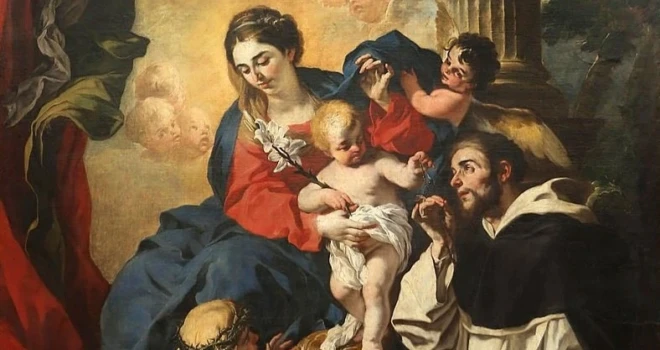As the Church celebrates the feast of St. Dominic, we are reminded not only of the man—the preacher, the founder, the father of the Order of Preachers—but also of the weapon he wielded in defense of truth: the Holy Rosary. Although its exact origins are in disagreement with some historians, what is beyond dispute is the Rosary’s deep association with Dominic and his mission to confront the great heresies of his time, especially the Cathars, or Albigensians, whose dualistic worldview threatened the foundations of Christian belief.
Our Lady told Dominic that the Rosary is the “battering ram” of false Christian teaching. But what did she mean?
What gave the Rosary its sharpest edge was its structure, and I don’t mean the repetition or the grouping of the prayers. I’m referring to the prayerful meditation on the mysteries of Christ’s life, death, and resurrection. In contemplating these mysteries, one is catechized by them. The Rosary is not merely prayed—it teaches. It forms the mind in truth and the heart in love.
And this is precisely why it was effective against the Cathars (the Albigensians). Their teachings were not just morally or philosophically off—they denied the Incarnation, the sacraments, and the goodness of creation itself. They struck down marriage and childbearing, and if a child was born, it couldn’t be baptized. What we will examine is how the Rosary, mystery by mystery, dismantles those errors not by argument alone, but by leading the soul into the luminous clarity of divine revelation.
Let’s examine each set of mysteries and how they directly oppose the teachings of the Cathars.
The Joyful Mysteries: Affirming the Goodness of Creation and the Incarnation
The Cathars believed that the material world was evil—a prison crafted by a lower god or evil spirit. Human bodies were to be escaped from, not sanctified. Marriage, childbirth, even the sacraments, were seen as part of this corrupt physical order.
But the Joyful Mysteries declare something radically different:
- The Annunciation – God becomes man. He takes on flesh. Far from fleeing creation, God enters it. The angel Gabriel’s announcement to Mary refutes the very core of Cathar cosmology.
- The Visitation – Mary, pregnant with the Son of God, brings the new Ark to Elizabeth. John leaps in the womb—an unborn child reacting to the presence of the Incarnate Lord. Life in the womb is sacred, not a trap.
- The Nativity – The Word becomes flesh and dwells among us. Christ is born not in celestial grandeur but into a real human family, with real human suffering and joy.
- The Presentation – Jesus is offered in the Temple according to the Law. He enters into the rituals and structures of the Old Covenant, affirming the continuity between flesh and faith.
- The Finding in the Temple – The incarnate Word learns, speaks, listens. God in the flesh is among the teachers. Human learning and reason are not traps, but paths to truth.
Each mystery affirms the dignity of matter, of the body, of human relationships, of covenant, and of the very idea that God makes Himself visible. These strike at the heart of Cathar contempt for the material world.
The Sorrowful Mysteries: Embracing the Body and the Cross
The Cathars rejected the crucifixion as something either illusory (since they believed Christ didn’t have a real body) or morally repugnant. Their Jesus did not suffer, did not die, and certainly didn’t rise bodily.
But the Sorrowful Mysteries show a God who loves unto death:
- The Agony in the Garden – Christ feels the weight of suffering. He sweats blood. This is no illusion. The Incarnate God experiences dread and sorrow as any human would.
- The Scourging at the Pillar – The body is not evil—but here it is wounded, lashed, torn for our healing. The physical suffering of Christ redeems the physical realm.
- The Crowning with Thorns – Even in humiliation, the Kingship of Christ shines through. The Cathars saw worldly suffering as meaningless; but for Christians, it becomes redemptive.
- The Carrying of the Cross – The path to Calvary is not one of escape, but of embrace. The cross is not avoided but accepted, sanctified by love.
- The Crucifixion – Christ dies a real death in a real body. There is blood, thirst, agony—and through it all, forgiveness and mercy. The cross is the culmination of the Incarnation, not a divine mistake.
These mysteries boldly confront the dualism of the Cathars. Jesus didn’t just appear human—He was human. And His suffering wasn’t an accident—it was the means by which He saved the world.
The Glorious Mysteries: Defeating Death and Restoring Creation
If the Cathars despised the material, they equally despised the resurrection of the body. For them, salvation meant escape from the body, not its glorification.
But the Glorious Mysteries reveal the truth:
- The Resurrection – Jesus rises bodily. The tomb is empty. He eats with His disciples. The resurrection is not a spiritual metaphor but a vindication of the whole of Christ’s humanity.
- The Ascension – The human body of Christ is taken into heaven. Matter is not left behind—it is raised.
- The Descent of the Holy Spirit – The Spirit descends on flesh-and-blood apostles, empowering the Church. The age of the Church begins with tongues, fire, and proclamation in the public square.
- The Assumption of Mary – The first disciple is taken into heaven, body and soul. A woman, a mother, a creature of flesh, is glorified.
- The Coronation of Mary – Not as goddess or abstraction, but as Queen of Heaven—crowned, exalted, and still human.
This set of mysteries silences the Cathar fear of the body and the world. It shows that redemption doesn’t come by rejecting creation but by recreating it from within. The body is not a cage but a temple destined for glory.
A Living Catechism in Beads
In this light, the Rosary becomes more than prayer—it becomes proclamation. Every Ave is a heartbeat echoing the truths of the Creed. Every decade is a lesson in Incarnation, Redemption, and Glory. It is no wonder that Dominic turned to the Rosary to preach to a people whose minds had been darkened by spiritual error. Where long theological treatises failed to move hearts, the Rosary allowed ordinary people to see Christ with the eyes of faith.
It is worth noting that the structure of the Rosary mirrors the structure of the Gospels. It is not merely Christ’s teachings that are highlighted, but His life. The mysteries are not abstract doctrines, but moments—revealed moments that confront falsehood by revealing reality.
Today, heresies still swirl around us: denial of the Incarnation, rejection of human dignity, confusion about suffering, and disdain for the body. And yet, the Rosary still works—not as magic, but as meditation, formation, and communion. In a world seduced by false lights, the Rosary remains a torch of fire.
St. Dominic knew this. He gave us not just words to say, but mysteries to live.
Author’s Note: Saint Dominic and the Rosary is a beautifully illustrated, faith-filled journey for children ages 7 and up. Through warm storytelling and vibrant art, young readers will discover the life of St. Dominic, the power of prayer, and how the Rosary can bring them closer to Jesus and Mary. With meditations on each set of Mysteries and step-by-step instructions for praying the Rosary, this book is the perfect introduction to one of the Church’s most beloved devotions—inviting kids not just to learn, but to pray. It is available in hardcover, e-book, and a beautifully narrated audiobook.
Image from Wikimedia Commons















